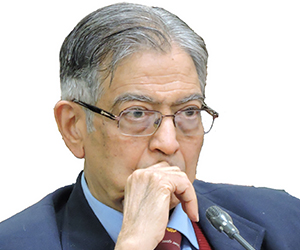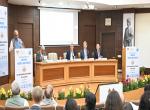The state visit to India of Japanese Prime Minister Noda for the annual Prime Ministerial Summit on December 27-28, 2011 has placed India-Japan ties on a firm upward spiral. Following the dip in relations as a result of adverse Japanese reactions to our nuclear tests in 1998 there has in the last decade been a steady improvement in links. This has been the result of a number of factors such as apprehensions of China, closer India-US relations, the absence of any bilateral disputes between the two countries, a common interest in maintaining the security of the sea lanes of communication, a shared recognition that the complementarities of the economies of the two countries provide huge opportunities for mutually beneficial economic cooperation and, ofcourse, a common commitment to the universal values of democracy, the rule of law, human rights and preservation of regional and international peace and security.
The steady consolidation of India-Japan links has been facilitated by the regular annual exchange of Prime Ministerial visits since April 2005. While the Japanese Prime Ministers visited India in 2005, 2007, 2009 and in 2011, Dr Manmohan Singh visited Japan in 2006, 2008 and 2010. The establishment of a Strategic and Global Partnership between the two countries during Dr Manmohan Singh’s visit to Tokyo in 2006 set the framework for taking the relationship to a higher level as it envisaged Political, Defence and Security Cooperation; Comprehensive Economic Partnership; Science & Technology Initiative; People-to-People exchanges and cooperation in Regional/Multilateral fora. It fostered regular multifaceted exchanges between the two countries at the Ministerial and official levels. The most notable of the latter is the 2+2 dialogue of the defence and foreign secretaries of the two countries the first meeting of which was held in New Delhi in July 2010. It is also significant that on the eve of Prime Minister Noda’s visit the first India-US-Japan trilateral took place with a focus on maritime security, counter terrorism, counter proliferation, disaster relief and humanitarian assistance. The second meeting of the trilateral is scheduled for next year in Tokyo. The three countries are already participating in the joint naval Malabar exercises since 2007.
India is today the largest recipient of Japanese overseas development assistance which over the last four years has been of the order of about $2.5 billion annually. This has naturally provided a fillip to the engagement between the two countries. Trade though only around $13 billion in 2008 has grown over three fold since 2001. Japan is today India’s third largest foreign investor and there are already over 800 Japanese companies working in India. The Delhi metro, the dedicated freight corridor, the Delhi-Mumbai industrial corridor, the spate of auto manufacturing facilities etc are only a few of the project on hand with Japanese support. This engagement will acquire vastly greater traction with the conclusion of the Comprehensive Economic Partnership Agreement in August 2011which extends not only to trade but also to services, investments etc.
An analysis of the 35 para Noda-Manmohan Singh joint communiqué of December 28th reveals the range and depth that India-Japan ties are on course to assume.
On the economic front the communiqué inter alia indicates that agreement was reached on the following:
- Japanese loan of $1.75 billion for Delhi metro phase III and West Bengal Forest and Biodiversity Conservation Project;
- The launch of a $9 billion India-Japan facility for the Delhi Mumbai Industrial Corridor (DMIC) with Japan committed to provide $4.5 billion through public private finance over 5 years. The DMIC project is set to redefine the character of infrastructure growth in India through Japanese advanced technology and green growth. The active involvement of Japanese companies and agencies in the DMIC would be given an enormous impetus as Japan would participate in the DMIC Development Corporation through equity, technical expertise and board members;
- With a view to similarly upgrading infrastructure in the Chennai-Bengaluru section Japan will extend technical and financial support to develop a Comprehensive Integrated Master Plan for the same;
- A feasibility study would be completed by 2012 for upgradation of speed of passenger trains in the Delhi-Mumbai sector. In addition, use of Japanese technology and assistance is under consideration for development of a high speed railway system in India;
- Enterprises of the two countries would jointly undertake industrial activities to produce and export rare earths;
- Maintaining a dialogue to maximize the potential of high technology trade;
- Commitment to further progress already achieved in the S&T relationship as reflected in joint R&D projects being implemented in molecular sciences, advanced materials, biotechnology, space sciences etc. In this context, it was agreed to further enhance business tie ups and explore opportunities for Japanese industries in electronics systems design and manufacturing in India;
- Enhancement of bilateral currency swap agreement from $3 billion to $15 billion.
- Strengthening cooperation in creative industries ranging from design, apparel, fashion, food, music, movies, animation and manga etc.
On the strategic front the Communique inter alia makes the following points of significance:
- Expansion of cooperation in maritime security, including safety and freedom of navigation and anti piracy activities, by promoting bilateral and multilateral exercises, and through information sharing, as well as dialogues. An exercise of the Indian and Japanese Coast Guard is scheduled for January 2012.
- Cooperating on Africa in areas such as development and peace keeping operations.
- A commitment to continuing assistance to Afghanistan so that it becomes a stable democratic and pluralistic state free from extremism and terrorism. Exploration of opportunities for consultation on their respective assistance projects.
- A condemnation of terrorism “in all its forms and manifestations, committed by whomever, wherever and for whatever purpose.” Agreement to develop greater cooperation in combating terrorism both bilaterally and through cooperation in multilateral fora. A recognition of the urgent need to finalise and adopt the Comprehensive Convention on International Terrorism in the UN which had been sponsored by India. In addition PM Noda “strongly condemned” the terrorist attacks in Mumbai in July 2011 and in Delhi in September 2011.
- A decision for enhanced cooperation in nuclear disarmament and non proliferation through bilateral dialogues and in the Conference on Disarmament. In this context, the joint commitment for immediate commencement and early conclusion of negotiations for a non discriminatory, multilateral and internationally and effectively verifiable Fissile Material Cut Off Treaty (FMCT) was underlined.
- A resolve to reform the UN Security Council including its expansion both in the permanent and non permanent categories.
- A reaffirmation of support to the East Asia Summit as a forum for dialogue on broad strategic, political and economic issues of common interest and concern with the aim of promoting peace, stability and economic prosperity in East Asia. Support was also expressed for the EAS as a leaders led forum with ASEAN as the driving force.
- A reaffirmation of the role of the G20 as the premier forum for international economic cooperation.
The one area in which the visit came up short was on civil nuclear cooperation. Japan has had long standing objections to engage in such cooperation with countries which are not signatories to the NPT. It had, however, been hoped in India that in view of the India-US nuclear deal, Japan would give up its reluctance for engaging in civil nuclear cooperation with India. Bilateral discussions between India and Japan have obviously not so far resolved this issue. The communiqué while recognizing the importance of civil nuclear cooperation envisages further talks. These talks will have to on the one hand get around India’s inability to sign the NPT and on the other hand address the Japanese position which makes it impossible to cooperate with a non signatory to the NPT. While this may appear difficult the issue could perhaps be finessed by grounding the cooperation on India’s impeccable record on non proliferation and its commitment to the same which has been better than that of many signatories of the NPT. To this may be added our moratorium on testing and our commitment to immediate negotiations on the FMCT and its early conclusion. Japan on its part would have, ofcourse, much to gain from such cooperation in economic and commercial terms.
Interestingly China finds no mention in the communique. It was certainly on the minds of the two sides but the anxiety to give no offence to that emerging Asian hegemon perhaps impelled the two sides from omitting any reference to it. Indeed, even China’s surrogates notably Pakistan and North Korea which certainly must have been the subject of some discussion find no mention. While the non articulation of the concerns aroused by these countries publicly is not a big issue it is to be hoped that these were discussed and broad understandings arrived at on the manner in which they should be addressed.
To conclude, therefore, there can be no denying that India-Japan ties are today well anchored and have assumed a multifaceted dimension. Given the commonalities and complementarities between the two countries relations between them are set to flourish and have the potential to transform India.
------------------------------------------
Published Date : 3rd January 2012









Post new comment